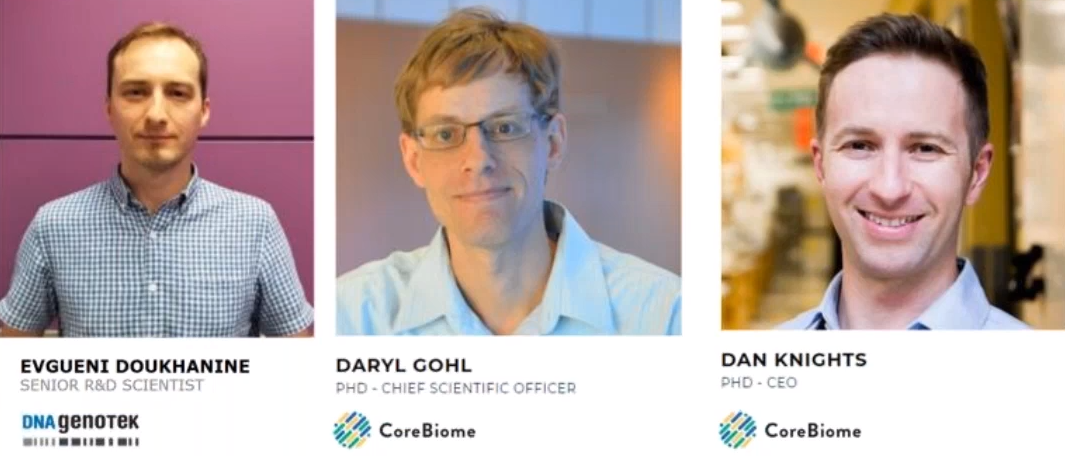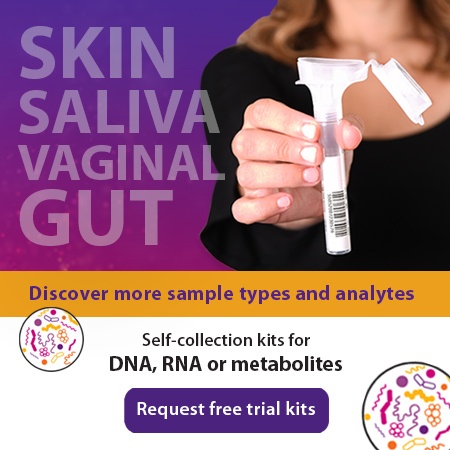2019-12-12
UPDATE: On May 12, 2020, CoreBiome rebranded as Diversigen Inc.
From sample collection to analysis, the ability to snapshot the microbial community and accurately analyze the results is key to the success of any study. To accomplish these feats, accurate and reproducible protocols for sample collection, DNA extraction, sequencing methodology and data interpretation are required. A webinar, hosted by the Microbiome Times, brought together leaders in the field to discuss standardization in microbiome measurements.
Speakers:
Evgueni Doukhanine, MSc, Senior Scientist, R&D; DNA Genotek, Inc.
Evgueni Doukhanine is a molecular biologist specializing in microbiome research and development of chemical reagents to facilitate stabilization of primary samples. At DNA Genotek he leads a team of scientists focused on microbiome and genomic sample stabilization chemistries, establishing chemistry patents, sample processing and sequencing methodologies.
Daryl Gohl, PhD, CSO; CoreBiome, Inc.
Daryl Gohl is a molecular biologist and geneticist with a strong track record of developing novel tools for answering biological questions, including patent-pending methods that are the basis for CoreBiome’s technology. He directs R&D at CoreBiome.
Dan Knights, PhD, CEO; CoreBiome, Inc.
Dan Knights is a computer scientist, computational biologist, and globally recognized expert in microbiome informatics who has developed some of the leading methods for analyzing microbiome data. He oversees informatics R&D at CoreBiome.
Webinar Highlights:
Considerations for fecal microbiome sample collection
When deciding on a stool sample collection method, it is important for microbiome researchers to consider neutrality, stability, and reproducibility. Mr. Doukhanine focused his talk on how these factors are important to ensure standardization in fecal microbiome studies in order to generate high quality and actionable results.
Neutrality – Collect an unbiased microbial profile at the time of collection
A frozen or chemically stabilized stool sample should be indistinguishable from a fresh sample that was extracted immediately. Mr. Doukhanine explains what can cause a shift in neutrality of stool samples:
“There are two different causes of a shift in neutrality: if your stabilization chemistry, for instance, impacts the lytic buffer that’s present in commonly used extraction kits, then you would not be able to recover an accurate representation of the in vivo microbial profile. The other is contamination, if your stabilization chemistry or collector physical design has significant contamination in it, it will mask the sample’s microbial profile.”
Stability – Preserve the microbial profile during shipping and storage
The microbial profile of a frozen or chemically preserved sample should not change in composition over time and should be identical to a sample extracted immediately after collection, regardless of shipping and storage conditions and/or elapsed time between collection and processing. Mr. Doukhanine explains,
“Sample stability can be impacted by biased microbial growth over time: if the preservation chemistry is providing any nutrient source, is non-lytic or non-stabilizing, or if there is selective degradation of DNA. When we talk about microbiome samples, we typically think of intact bacteria, however there is a wealth of DNA available from already lysed bacteria or bacteria in the process of lysis [that could misrepresent your sample], so you want to make sure you’re stabilizing that DNA and any other analyte from those sources.”
Reproducibility – Rapidly homogenize the collected sample
Multiple aliquots extracted from the same specimen should be similar to one another. Stool can be very heterogeneous, so it is critical to fully homogenize the sample in order to ensure data reproducibility across extractions.
“If you don’t have proper mixing within your collection and stabilization device, your extraction efficiency can be impacted.”
To find out more about testing neutrality, stability and reproducibility in sample preservation technology, please, read DNA Genotek’s whitepaper, entitled “Powering a pilot study: How to design an experimental plan to compare the performance of collection/preservation methods”.
Considerations for data generation
Once the samples are collected using a standardized method, the next steps are extraction, sequencing and analysis. Dr. Gohl described experiments that CoreBiome has conducted measuring intra-run, inter-run and inter-operator variability for stool samples collected in OMNIgene·GUT fecal collection and stabilization kits. Dr. Gohl discussed the process of comparing intra-run, inter-run and inter-operator variability samples.
“To test intra-run variability, we took three replicates of the same sample processed on the same library preparation plate, by the same technician, taken all the way through to sequencing. We also ran a study on inter-run variability where we took three sets of replicates (three samples, three replicates each) and processed them on three different library preparation plates and took them through on three different sequencing runs. We also looked at inter-operator variability - this is two different technicians in the lab, each processing a replicate set of samples on a different plate.”
When comparing the coefficient of variation between the Shannon diversity measurements of samples, you can determine the impact of the technical variance on the microbiome profiles, relative to the biological variance. The lower the technical variance, the smaller the bias or noise introduced by your extraction and sequencing methods, the more confident you can be in your sequencing results.
Considerations for analysis
After generating high-quality data, the challenge is to use those data using appropriate informatics analyses. Dr. Dan Knights highlighted some of the consideration you are faced with when designing your study and statistical approach.
“How should you design a study based on what you are trying to test? How do you deal with various confounders? What are the main confounders and how should you account for them - by the study design itself or through the statistics? What are the best statistics to use given the different types of study design?”
If you’d like help tackling these challenges or have questions about microbiome study design, sample extraction and sequencing analysis reach out to the team at info@dnagenotek.com.



